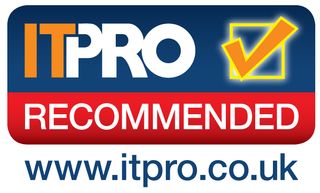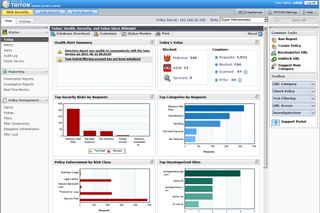IT Pro Verdict
Mid-sized business and enterprises looking for a single appliance to take care of all their network security needs will find Websense’s TSGA ideal as it combines a remarkable range of web, mail and data security features with excellent performance. Websense’s TruHybrid is compelling with both the on-premises and SaaS cloud services seamlessly integrated into the well designed central management console.

The Websense Triton Security Gateway Anywhere v10000 appliance

All TSGA components are managed from the USC console which provides plenty of detail on activity and detected threats.

Websense provides comprehensive lists of web categories and protocols which can be combined in the same security policy.

Anti-spam policies are simple to create and can use an extensive array of scanning techniques.

DLP policies can include regulatory compliance checks where selecting the region activates the most appropriate standards.

Messages and attachments can be checked for specific patterns and phrases and Websense includes a huge list of predefined one
Most UTM products use one or more third-party components for essential tasks such as web content filtering, anti-spam or virus scanning but Websense's latest Triton Security Gateway Anywhere (TSGA) is completely home grown. It only uses technology which the company has either developed itself or acquired over the years.
TSGA benefits from Websense's innovative TruHybrid service which combines both on-premises and SaaS cloud services for web content and email scanning.

TSGA benefits from Websense's innovative TruHybrid service which combines both on-premises and SaaS cloud services for web content and email scanning. This allows businesses to deploy appliance-based scanning at the head office and use the SaaS component to extend the same levels of data security to branch offices and remote workers.
Competing products only offer either on-premises or cloud scanning and generally rely on third party vendors to provide these services. Uniquely, both TruHybrid components are managed from the same management console and can be configured using a single security policy.
TSGA has a wide range of options that can be purchased separately and the v10000 appliance on review runs everything on one platform. The appliance is based on a good quality Dell PowerEdge R610 server with enough grunt to handle all security services for up to 2,500 users.
To test the v10000 appliance we slotted it into the lab network which had Dell PowerEdge servers running Windows Server 2008 R2 domain and internal email services. Windows 7 clients were configured to use the appliance as their proxy and to test the email DLP (date leakage prevention) feature we added another server providing external mail services.

All management is via the intuitive Unified Security Center (USC) web interface which uses three separate tabs for the web, data and email components. Customisable dashboards are provided with each one showing details such as detected security risks, threats, viruses and so on.
Dave is an IT consultant and freelance journalist specialising in hands-on reviews of computer networking products covering all market sectors from small businesses to enterprises. Founder of Binary Testing Ltd – the UK’s premier independent network testing laboratory - Dave has over 45 years of experience in the IT industry.
Dave has produced many thousands of in-depth business networking product reviews from his lab which have been reproduced globally. Writing for ITPro and its sister title, PC Pro, he covers all areas of business IT infrastructure, including servers, storage, network security, data protection, cloud, infrastructure and services.
